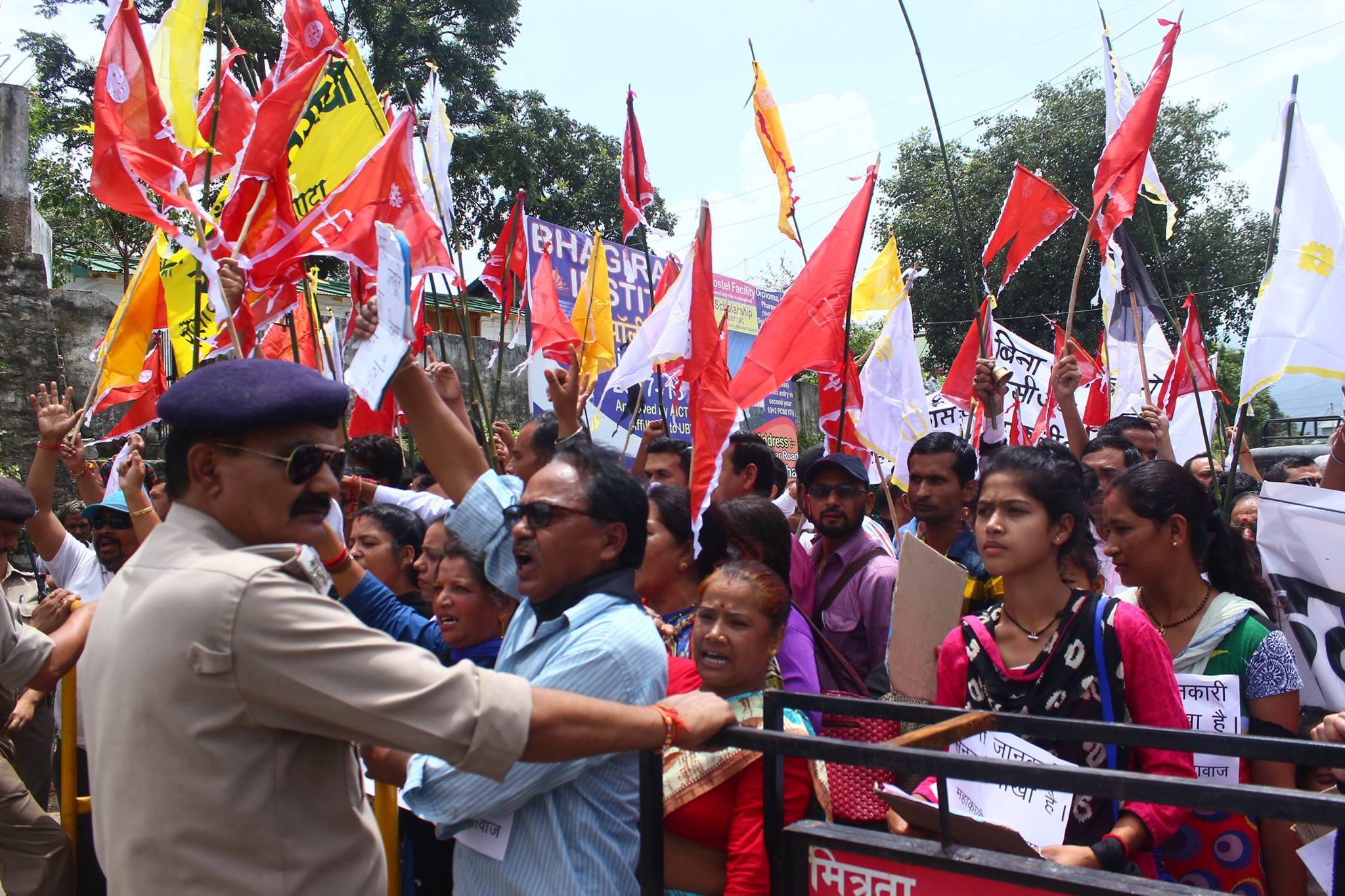As the Expert Appraisal Committee of the Ministry of Environment for River Valley Projects discussed the matter of world’s second highest dam, today, a small group of peaceful protestors stood outside to voice their dissent. “We are here to ask how the committee will take a decision in 45 minutes about a project on which 40000 crores are going to be spent and which is going to determine the fate of 50,000 people in two countries”, said Vimal Bhai of Matu Jan Sangathan standing outside the gate of the Ministry premises today.
Several affected communities, environmental groups and people’s organisations sent in written objections voicing serious concerns related to the 5040 MW Pancheshwar Multipurpose project which is proposed to be constructed in Uttarakhand and Nepal. The EAC in its meeting today was deliberating on the environment clearance for the project. The scoping clearance for this dam which has been in the pipeline for decades, was granted in October 2016. While the EAC to start with seemed to raise some issues and even set up a joint mechanism (indo-nepal) for environmental impact assessment in May 2017 it reversed its decision on the ground that it would “unnecessarily” delay the process.
Since then it has been clear that the MoEF, the state administration and project proponents were in a rush to push the project as the publci consultations were announced in the month of August. Says Shankar Kharayat of Mahakali ki Awaaz, “The project affected villages in this part of Uttarakhand lack proper road connectivity and are known for landslides during the monsoon. The decision to announce the Public Hearing in the month of August was a faulty one because of this reason that it would be difficult for the news to reach the affected people and then the people to reach the Public Hearing venue. As a result of the nature of public consultation, the lack of availability of complete information about the project, the lack of access to relevant documents (EIA-EMP report in Hindi, Executive Summary in Hindi and Social Impact Assessment Report in Hindi) as well as lack of clarity about the objective of the public consultation process, the affected people were agitated before the public consultation. Several submissions were made asking for postponements of the hearings to the State Pollution Control Board vide the District Administration. However no heed was paid to these appeals by the government.”
31,023 families are going to be impacted by this project which will submerge 11, 600 hectares land in 134 villages on the Uttarakhand side alone. Additionally, 3 districts of Nepal are going to be impacted as well. Hundreds of people protested at the three public consultations that were organised in closed premises in Champawat, Pithoragarh and Almora district headquarters. Very few people could make their submissions and yet the written submissions alone go well into 650 plus pages. Several made oral testimonies which did not come on record even. Himanshu Thakkar of South Asia Network on Dams, rivers and people in his submission has done a scathing critique of the shoddy EIA study done by WAPCOS. “There are many instances that show that the EIA is unscientific, wrong, inadequate and callous”, he said.
Himdhara Environment and Research Collective in its submission said, “We would like to remind the EAC about the report Performance Audit done by the Comptroller and Auditor General of India (CAG) in the year 2016 which unambiguously stated that the existing processes for grant of Environmental Clearance are fraught with serious violations, noncompliance and deficiencies. In fact River Valley and Hydroelectric Projects have been highlighted for poorest quality of Environmental Impact Assessment (EIA) Reports, maximum irregularities during Public Hearings, and non-compliance of Environmental Clearance conditions”.
According to the CAG scrutiny for six out of seven projects the RVP EIA reports did not comply with the Terms of Reference granted by EAC as well as generic structure stipulated in the EIA notification. Even though the sample size is smaller in RVHP projects percentage wise non-compliance is highest. CAG also highlights the fact that the projects have been granted ECs despite evident shortcomings in the preparation of the EIA reports with respect to the ToRs. CAG observed that the due diligence process as prescribed in the EIA Notification for the conduct of Public Consultation was not followed in any of the seven sectors examined in Audit. The non-compliance was maximum in case of River Valley and Hydro Electric projects.
“It is a matter of grave concern that the indictment by a body like CAG has not served as any feedback for the EAC River Valley Projects and it has shown a complete lack of diligence in the same areas where red flags have been raised by the CAG. It is the responsibility of the EAC to exercise caution and commitment in cases of projects that are having such a far reaching impact.”
Most of the submissions have made a demand that the EAC should not grant the project an environmental clearance on the grounds of an incomplete and inadequate EIA report and several procedural violations in the EIA process.
The Pancheshwar Dam on the Mahakali River, is apparently a pet project of the Prime Minister who has been singing its paeans at various fora. However, there has been no mention of the fact that the hydropower sector is in a massive slump while 13 projects are being considered for a bailout package of 26000 crore due to the financial un-viability of these projects especially in the Himalayan region. Its been about 4 years since the Kedarnath tragedy and much has been said about the fragile ecology and geology of the Himalayas which has been tampered with by large scale construction and development activities by scientists, citizens and environmentalists. However, PM Modi steered clear of even mentioning it in his recent visit to Kedarnath.
For More information:
Shankar Kharayat, 9411336093, Mahakali ki Awaaz
Vimal Bhai, 9718479517, Matu Jan Sangathan
Himanshu Thakkar, 9968242798 Sandrp,
Manshi Asher 8988275737, Himdhara Collective






